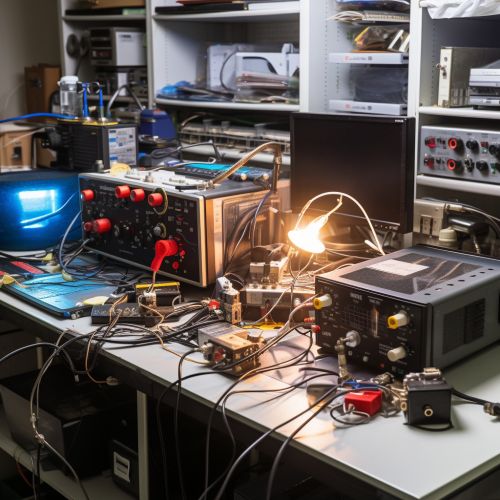Quantum Hall state
Introduction
The Quantum Hall state is a phase of matter characterized by the quantization of the Hall conductance. It is a macroscopic quantum state that arises in two-dimensional electron systems subjected to low temperatures and strong magnetic fields. This quantum state exhibits many fascinating properties, including fractional charge and statistics, and topological order.
Discovery and History
The Quantum Hall state was first discovered in 1980 by the German physicist Klaus von Klitzing while studying the Hall effect in two-dimensional electron systems at low temperatures and high magnetic fields. This discovery led to a new understanding of quantum mechanics and the behavior of electrons in two dimensions, and was awarded the Nobel Prize in Physics in 1985.


Quantum Hall Effect
The Quantum Hall Effect is the phenomenon that gives rise to the Quantum Hall state. It is a quantum-mechanical version of the classical Hall effect, which describes the generation of a voltage difference across an electrical conductor, transverse to an electric current in the conductor and a magnetic field perpendicular to the current. In the Quantum Hall Effect, the Hall conductance, which is the ratio of the transverse voltage to the current, is quantized in units of the fundamental constant e^2/h, where e is the electron charge and h is Planck's constant.
Theoretical Understanding
The Quantum Hall state can be understood within the framework of the Landau level theory, which describes the motion of charged particles in magnetic fields. In this theory, the energy levels of the electrons in the magnetic field are quantized, leading to the formation of so-called Landau levels. The filling of these levels by the electrons leads to the quantization of the Hall conductance.
Fractional Quantum Hall State
A more exotic phase of the Quantum Hall state is the Fractional Quantum Hall state, which was discovered in 1982. In this state, the Hall conductance is quantized in fractions of the fundamental constant e^2/h. This state is believed to arise due to strong electron-electron interactions, which lead to the formation of new quasiparticles with fractional charge and statistics.
Topological Order
One of the most intriguing aspects of the Quantum Hall state is its topological order. This is a type of long-range quantum entanglement that gives rise to robust and non-local properties, such as fractional charge and statistics, and a degenerate ground state on a torus. The topological order in the Quantum Hall state is related to the concept of the Chern number, a topological invariant that characterizes the quantization of the Hall conductance.
Applications
The Quantum Hall state has found applications in precision measurements and quantum computing. The quantization of the Hall conductance in the Quantum Hall state is used to define the standard of electrical resistance, known as the von Klitzing constant. Furthermore, the topological properties of the Quantum Hall state are being explored for use in topological quantum computing, a novel approach to quantum computing that is robust against local errors.
